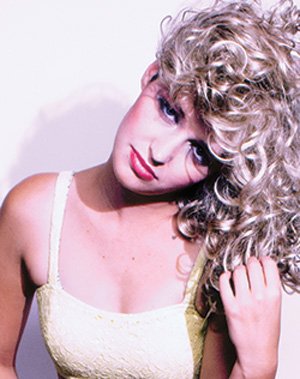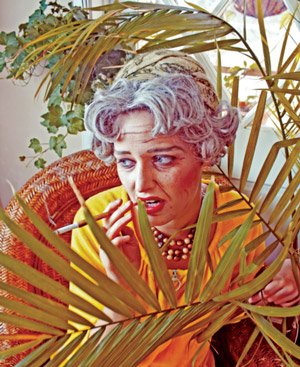Portland Artist Lenae Day


Lenae Day is a northwest artist currently living in Los Angeles. Her work is subversively feminist, using a mixture of graphic design and multimedia. This is the future of a new type of tangible performance art—a show where you don’t know what to expect, but you know you most likely won’t be covered in human urine if you sit in the front row (like performance art has a reputation for doing to enthusiastic front row audience members). At the same time, you still get the benefit of being transported into the artist’s world like only good performance art can do.

ELEVEN: Please describe your medium.
Lenae Day: I was a painting major in art school, and I was painting myself into all of these old 1950’s ads. I thought that it didn’t make any sense to paint and have it also be a photograph, so I wanted it to be like an artifact instead of a painting—more like an interpretation of an artifact. So I started restaging these ads I was obsessed with. I wanted to write about them in some way. I stage all my own photographs, but they are usually based on exisiting images. Sometimes I make them up. They are usually historical vintage photographs. I have an imaginary hollywood family called the Prescott Sisters. Instead of the Warner Brothers it’s the Prescott Sisters. I play 100 percent of all the characers. All of the characters are based on actual historical actors and actresses.
11: Why are you drawn to the ads?
LD: The color and the printing quality. Also the messages in the ads. I don’t think they are as antiquated as we might think. I think we have the same messages being given to us in today’s women’s magazines and in the media. Everything I do is very subconcious. I get obsessed with something and follow it. I try to get to the bottom of why I’m obsessed with it in the first place. I guess through the years I figured out that’s kind of what it is with the ads. As ridiculous as the ads seem, or the images seem, now they’re not antiquated at all. They are all still relevant.
11: So what’s your current obsession?
LD: Well, the Prescott family. My imaginary Hollywood family that spans from the 1920’s through the 1980’s. Doing shows in LA.
11: Any recent noteworthy shows?
LD: I had a show at Mark Moore Gallery in January. I was invited to do a solo show after participating in a group show called Imaginary Movies where I made six movie posters that kind of told the story of this family through the movie posters. The movies that they are in reflect what’s happening in their real lives. For example, in one of the posters the main movie star’s husband leaves her for her daughter and that’s the same as what’s happening in her real life. It was really fun to come up with the plots and it gave me a lot more material. I had enough material to create a museum in homage to the Prescott family. Like the Hollywood Museum. The Hollywood Museum is fascinating, too, because it’s in the old Max Factor building. I made movie posters, portraits, costumes, and a whole set of mannequins’ crown molding and display cases. My magazine is the mass-produced way that I present the material.
11: Tell me about Max Factor.
LD: That’s where all the old movie stars would go to have their makeup done by him, but also to have their looks defined. So in the 1930’s, you would come in and be a starlet, and then if you were going to become a really big star you would get sent to see Max Factor and he would decide what your look was going to be. For example, Joan Crawford’s Caterpillar eyebrows or the shape of the lips, which were totally fake. You know, everything. . . Gina Harlow, her dyed blonde hair. Lucille Ball—bright red hair. They all changed so much, and their defined looks were all created by Max Factor.
11: So you consider yourself a feminist then?

LD: Yes, very much. I get frustrated with the way contemporary women are portrayed. They are written for, and for the most part very affected in their voice and manner. They aren’t really written as smart characters. If you look at the old movies from the ’30s, ’40s, or even into the ’50s, women were allowed to be the agent of their own lives. Katherine Hepburn, Bette Davis, Joan Crawford—they were such badasses. The sexist roles did exist too, but I would say for the most part when I watch old movies I’m just like, “What?!” It was normal to have the strong smart independent woman. People paid money to go see those movies. Now women’s pictures aren’t made anymore. A lot of it may have to do with the studio system collapsing, too. In a way that’s a good thing. There was a monopoly and the studios couldn’t own the movie houses anymore. The studios had a vested interest in developing their stars and a wide array of things they provided to the public. But also TV didn’t exist either, so it’s kind of complicated. The main thing I guess is that I’m trying to pull out these moments in history where womanhood was expansive. I’m trying to remind myself, too—remind myself how I want to be in the world. I don’t have the same kind of role models today like these women were to the women of their generations. Once Marilyn came on the screen, women were back into girdles and in the kitchen.
11: What era do you think women actually had the most power?
LD: I kind of always go back to the 1940’s. Pantsuits with giant shoulders. . . but even the 1920’s when people were happy to have survived WW I. You read Dorothy Parker and you’re like, “Wow!” Bette Davis and Katherine Hepburn came out of that culture of the ’20s. Joan Crawford was described by F. Scott Fitzgerald as the ideal flapper. People often forget this part of her career.
11: What artists inspire you?
LD: Eleanor Antin, Cindy Sherman, all the movie stars I’ve referenced, Dorothy Parker, Tina Fey, Amy Poehler. There are so many more.
11: Current work or future work?
LD: Finishing the Prescott story and making a feature-length documentary. The youngest character Tiffany is still alive, so what is she doing? I am developing Phyllis, my historian, to help tell the Prescott family story. Some of the characters are really starting to take on a life of their own. Focusing on themes of narcissism and voyeurism. A web series, an audio show with a fake radio station. Making fun of things that make me mad. »
– Veronica Greene



